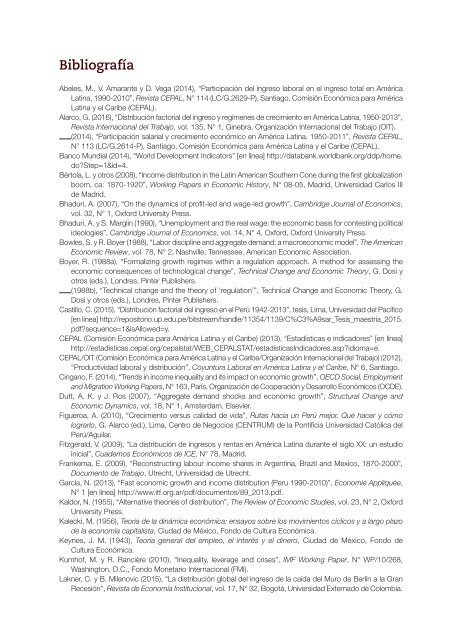Revista CEPAL no. 125
Agosto 2018
Agosto 2018
Create successful ePaper yourself
Turn your PDF publications into a flip-book with our unique Google optimized e-Paper software.
Bibliografía<br />
Abeles, M., V. Amarante y D. Vega (2014), “Participación del ingreso laboral en el ingreso total en América<br />
Latina, 1990-2010”, <strong>Revista</strong> <strong>CEPAL</strong>, N° 114 (LC/G.2629-P), Santiago, Comisión Económica para América<br />
Latina y el Caribe (<strong>CEPAL</strong>).<br />
Alarco, G. (2016), “Distribución factorial del ingreso y regímenes de crecimiento en América Latina, 1950-2013”,<br />
<strong>Revista</strong> Internacional del Trabajo, vol. 135, N° 1, Ginebra, Organización Internacional del Trabajo (OIT).<br />
(2014), “Participación salarial y crecimiento económico en América Latina, 1950-2011”, <strong>Revista</strong> <strong>CEPAL</strong>,<br />
N° 113 (LC/G.2614-P), Santiago, Comisión Económica para América Latina y el Caribe (<strong>CEPAL</strong>).<br />
Banco Mundial (2014), “World Development Indicators” [en línea] http://databank.worldbank.org/ddp/home.<br />
do?Step=1&id=4.<br />
Bértola, L. y otros (2008), “Income distribution in the Latin American Southern Cone during the first globalization<br />
boom, ca: 1870-1920”, Working Papers in Eco<strong>no</strong>mic History, N° 08-05, Madrid, Universidad Carlos III<br />
de Madrid.<br />
Bhaduri, A. (2007), “On the dynamics of profit-led and wage-led growth”, Cambridge Journal of Eco<strong>no</strong>mics,<br />
vol. 32, N° 1, Oxford University Press.<br />
Bhaduri, A. y S. Marglin (1990), “Unemployment and the real wage: the eco<strong>no</strong>mic basis for contesting political<br />
ideologies”, Cambridge Journal of Eco<strong>no</strong>mics, vol. 14, N° 4, Oxford, Oxford University Press.<br />
Bowles, S. y R. Boyer (1988), “Labor discipline and aggregate demand: a macroeco<strong>no</strong>mic model”, The American<br />
Eco<strong>no</strong>mic Review, vol. 78, N° 2, Nashville, Tennessee, American Eco<strong>no</strong>mic Association.<br />
Boyer, R. (1988a), “Formalizing growth regimes within a regulation approach. A method for assessing the<br />
eco<strong>no</strong>mic consequences of tech<strong>no</strong>logical change”, Technical Change and Eco<strong>no</strong>mic Theory, G. Dosi y<br />
otros (eds.), Londres, Pinter Publishers.<br />
(1988b), “Technical change and the theory of ‘regulation’”, Technical Change and Eco<strong>no</strong>mic Theory, G.<br />
Dosi y otros (eds.), Londres, Pinter Publishers.<br />
Castillo, C. (2015), “Distribución factorial del ingreso en el Perú 1942-2013”, tesis, Lima, Universidad del Pacífico<br />
[en línea] http://repositorio.up.edu.pe/bitstream/handle/11354/1139/C%C3%A9sar_Tesis_maestria_2015.<br />
pdf?sequence=1&isAllowed=y.<br />
<strong>CEPAL</strong> (Comisión Económica para América Latina y el Caribe) (2013), “Estadísticas e indicadores” [en línea]<br />
http://estadisticas.cepal.org/cepalstat/WEB_<strong>CEPAL</strong>STAT/estadisticasIndicadores.asp?idioma=e.<br />
<strong>CEPAL</strong>/OIT (Comisión Económica para América Latina y el Caribe/Organización Internacional del Trabajo) (2012),<br />
“Productividad laboral y distribución”, Coyuntura Laboral en América Latina y el Caribe, N° 6, Santiago.<br />
Cinga<strong>no</strong>, F. (2014), “Trends in income inequality and its impact on eco<strong>no</strong>mic growth”, OECD Social, Employment<br />
and Migration Working Papers, N° 163, París, Organización de Cooperación y Desarrollo Económicos (OCDE).<br />
Dutt, A. K. y J. Ros (2007), “Aggregate demand shocks and eco<strong>no</strong>mic growth”, Structural Change and<br />
Eco<strong>no</strong>mic Dynamics, vol. 18, N° 1, Amsterdam, Elsevier.<br />
Figueroa, A. (2010), “Crecimiento versus calidad de vida”, Rutas hacia un Perú mejor. Qué hacer y cómo<br />
lograrlo, G. Alarco (ed.), Lima, Centro de Negocios (CENTRUM) de la Pontificia Universidad Católica del<br />
Perú/Aguilar.<br />
Fitzgerald, V. (2009), “La distribución de ingresos y rentas en América Latina durante el siglo XX: un estudio<br />
inicial”, Cuader<strong>no</strong>s Económicos de ICE, N° 78, Madrid.<br />
Frankema, E. (2009), “Reconstructing labour income shares in Argentina, Brazil and Mexico, 1870-2000”,<br />
Documento de Trabajo, Utrecht, Universidad de Utrecht.<br />
García, N. (2013), “Fast eco<strong>no</strong>mic growth and income distribution (Peru 1990-2010)”, Eco<strong>no</strong>mie Appliquée,<br />
N° 1 [en línea] http://www.itf.org.ar/pdf/documentos/89_2013.pdf.<br />
Kaldor, N. (1955), “Alternative theories of distribution”, The Review of Eco<strong>no</strong>mic Studies, vol. 23, N° 2, Oxford<br />
University Press.<br />
Kalecki, M. (1956), Teoría de la dinámica económica: ensayos sobre los movimientos cíclicos y a largo plazo<br />
de la eco<strong>no</strong>mía capitalista, Ciudad de México, Fondo de Cultura Económica.<br />
Keynes, J. M. (1943), Teoría general del empleo, el interés y el dinero, Ciudad de México, Fondo de<br />
Cultura Económica.<br />
Kumhof, M. y R. Rancière (2010), “Inequality, leverage and crises”, IMF Working Paper, N° WP/10/268,<br />
Washington, D.C., Fondo Monetario Internacional (FMI).<br />
Lakner, C. y B. Mila<strong>no</strong>vic (2015), “La distribución global del ingreso de la caída del Muro de Berlín a la Gran<br />
Recesión”, <strong>Revista</strong> de Eco<strong>no</strong>mía Institucional, vol. 17, N° 32, Bogotá, Universidad Externado de Colombia.


















